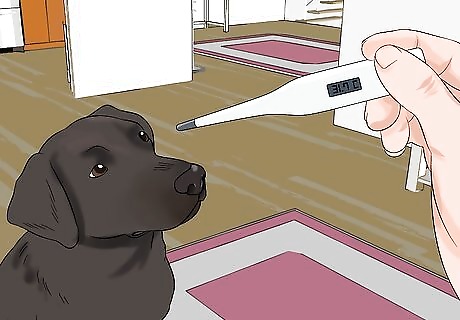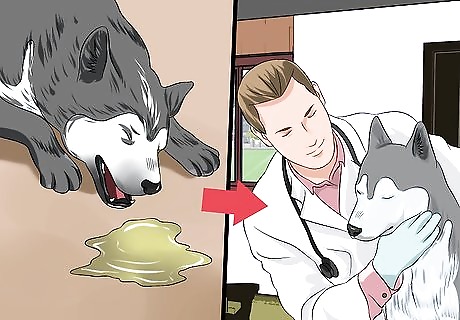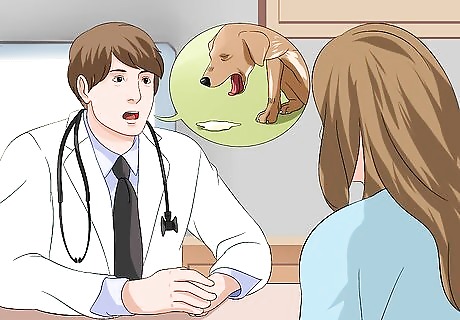
views
Recognizing the Symptoms of the Virus

Notice if your dog becomes feverish and loses his appetite. Once your dog has contact with the virus, it may incubate in his body for three to six days. Your dog may become feverish, lose his appetite, and have general head cold symptoms like a runny nose. He may also appear slightly off color or noticeable ill. Blood tests taken at this time would show a dip in his white cell count, as his body is using up white cells to fight off the infection.

Pay attention if the fever recurs and he exhibits head cold symptoms. The first stages of the virus can be subtle and may be missed or incorrectly labeled as a fever or a head cold. Your dog’s fever may wane and he may appear normal for a few days. Then, the fever will return a second time and your dog may have very intense head cold symptoms, like thick, snotty discharge from his nose, yellow-green discharge from his eyes, and coughing and sneezing.

Bring your dog to the vet if your dog remains unwell and starts to vomit or have diarrhea. At this point, your dog will appear very unwell and likely start to have gastrointestinal issues, like vomiting and diarrhea. These are all signs of canine distemper and means it is time to take your dog to the vet. As well, once your dog becomes unwell, his immune system will be weak, making him more vulnerable to secondary infections. This is especially prevalent in young dogs, as many young dogs die from distemper due to complications like pneumonia.

Take your dog to the vet if he appears weak, cannot see or stand, and has seizures. A certain strain of distemper can cause inflammation of your dog’s brain about two to three weeks into the infection. This can then lead to symptoms like stupor, weakness or dullness, an inability to see or stand and seizures. This strain can develop pretty fast, within two to three weeks, or several months to one year later in dogs with strong immune systems. If the brain damage is not as severe due to this strain, your dog may still have a permanent “tick”, where they twitch or jitter uncontrollably from time to time. Another late stage symptom is the development of “hard pads”, where the pads and the nose of your dog appear extended and excessive. This is due to hyperkeratosis, the excess production of keratin, which is the horny substance that makes up your dog’s pads and nose.
Getting a Diagnosis from the Vet

Allow your vet to confirm your dog’s symptoms. Though there are laboratory tests that can be done to detect if your dog has the virus, your vet should also take into account your dog’s symptoms, your dog’s age, and his immune status. She may do a physical exam and ask you when your dog’s symptoms first appeared, as well as how they have progressed. Dogs who are not vaccinated or do not have their booster vaccinations are more susceptible to canine distemper. As well, puppies and young dogs are also more at risk. This is why dogs most at risk for canine distemper are shelter dogs with unknown vaccination histories or pet-shop puppies with an unknown breeding history or bred from an unwell mother. Keep in mind that your dog’s vet may decide to try treatment options and see how the dog responds versus trying to diagnose distemper. This is because testing may be expensive and there is no cure for distemper.
Allow your vet to collect blood and tissue samples from your dog. Your dog’s veterinarian may need to collect a sample of the fluid surrounding your dog’s eyes, mouth, or from the windpipe, vulva, or white cell layer in a spun blood sample. Your vet may also need a sample of your dog’s blood and cerebral spinal fluid. Fluid samples can be inspected under a microscope to detect the presence of distemper. A PCR test may also be performed to evaluate for distemper virus. Blood and cerebral spinal fluid test results may be compared to detect the presence of distemper. However, collecting the cerebral spinal fluid comes with some risks.

Diagnostics may not always confirm canine distemper. Your vet may run blood tests to rule out other conditions, like leukemia or organ failure. There is also a specific test that tests for canine distemper yet depending on the disease course, sample collection, and the dog’s immune status, it does not always detect canine distemper. Your dog’s body may also be overwhelmed by the virus and be unable to produce antibodies. This means the test results could come back as a false negative, which is due to your dog being too sick to respond to the test.

Receive treatment instructions from the vet. Though there is no medication currently available that can eliminate canine distemper, the vet can provide intravenous fluids to prevent your dog from getting dehydrated due to the infection. She may also provide antibiotics to prevent the development of secondary infections while your dog tries to build up his immunity to other diseases or infections. Keep in mind that though some dogs can survive canine distemper, the infection can be fatal for dogs. If your dog recovers from canine distemper, he may experience seizures or other central nervous system disorders that may only appear many years later. He may also have permanent brain and nerve damage, with symptoms that only appear in his later years.



















Comments
0 comment